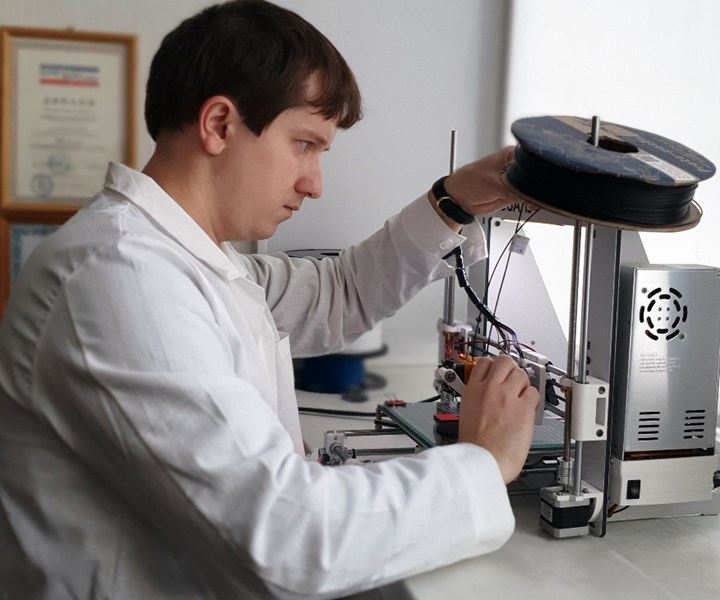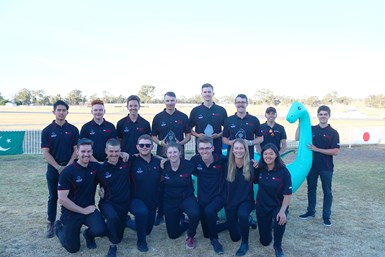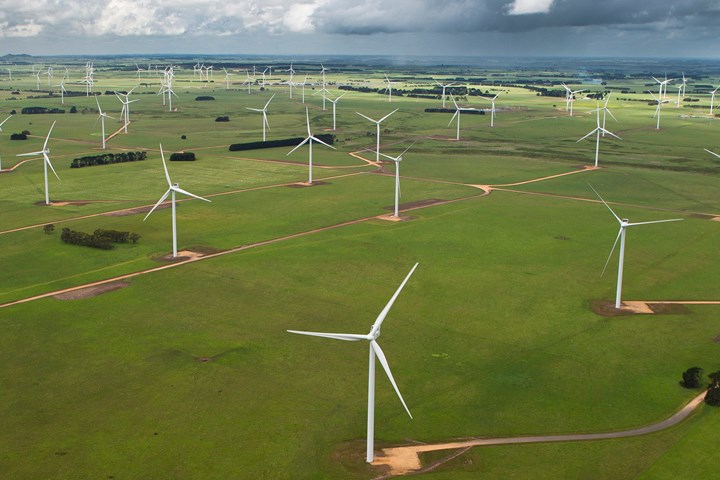CompositesWorld News for Jan. 07, 2020
Read news from ATL Composites Pty., Altair Engineering, Fives Cincinnati, and Oak Ridge National Laboratory
Radiophysicists study the properties of composites for 5G devices
Radiophysicists at Tomsk State University are forming a database of composite materials properties for creation of 5G and space communication devices.

Source | Tomsk State University
Radiophysicists at Tomsk State University (TSU, Tomsk, Russia) are forming a database of composite materials properties that they say can be used to create 5G and space communication devices operating in the terahertz range. The scientists are creating composite materials from acrylonitrile butadiene styrene (ABS) plastic and carbon nanotubes (see CW’s primer on nanomaterial types and definitions), and measuring their properties in a frequency range from 10 megahertz to 1 terahertz.
To create the source material, the radiophysicists are using polymers and, aided by chemical treatment, filling them with carbon nanotubes, which the Boreskov Institute of Catalysis of the Siberian Branch of the Russian Academy of Sciences produces for the Terahertz Laboratory of the Faculty of Radiophysics.
“By adding nanotubes of different concentrations, we change the electrophysical properties of the material; for example, we can increase the dielectric constant,” explains Alexander Badyin, project manager, associate professor of the Faculty of Radiophysics. “Then, using 3D technology, a printed circuit board with elements (conductors, resistors, and others) can be created. From the material obtained on a 3D printer, we print a control sample — plates or rings, depending on the standard of the measuring installation, and examine the properties of the composite in the terahertz range.”
According to the researchers, the interest of scientific groups is mainly concentrated in household radiation up to 4-5 gigahertz. TSU scientists are working with a wider range — up to 1 terahertz, which the researchers say is currently insufficiently studied. According to a December 2019 news release, they have currently studied the properties of 50 samples.
ATL Composites contributes to student-built racing car
ATL Composites worked with Griffith University engineering and design students to construct a competitive racing vehicle featuring carbon fiber composites.

Source | ATL Composites
ATL Composites (Molendinar, Queensland, Australia) worked with Griffith University (Brisbane, Queensland, Australia) engineering and design students to expand their expertise in composite materials in the construction of a vehicle that competed in the December 2019 Formula SAE Australasia competition.
For the Formula SAE Australasia competition, around 35 universities from around the world design, build and compete in Formula-style, open-wheeled racing cars as part of a 12-month curriculum program.
The lightweight, 240-kilogram Griffith Racing Team car, known as GRT19 “Bronte,” placed third overall for Internal Combustion vehicles, their best performance yet.
According to Daniel Scherger, head of sponsorship at the Griffith Racing Team, “A major goal of the project was to complete a full aerodynamic package for our vehicle,” Scherger says. “Composite manufacturing has been an area of knowledge the team lacked after completing three vehicles previously with little composite material. This year we wanted to expand our knowledge and utilize the performance benefits of composite materials for the car.”

The Griffith Racing Team. Source | ATL Composites
The team worked with ATL Composites for supplies and advice. “ATL is a trusted local supplier in South East Queensland, so we could ensure that the use of their products would result in quality components for the vehicle this year,” Scherger says. “With ATL Composites being so close to our university we could have regular meetings with the business, and they provided fast turnarounds for products.”
The Griffith car included curved carbon fiber composite endplates. For this project, ATL provided carbon fiber and glass fiber rolls, as well as Divinycell foam, the Duratec surfacing range, Techniglue high strength adhesives and Kinetix laminating epoxy systems.
“We spent time with the Griffith designers to provide a comprehensive package and training in how to use the products to best advantage,” says Jonah Osborne from ATL Composites. “They picked it up quickly and were pleased with the strength and light weight they were able to achieve with composite materials.”
The project commenced in January 2019 with the aim of completing the vehicle by November in time for the event in early December.
“It was a major challenge for the team to learn composite manufacturing from scratch; from composite molds to manufacturing components like the endplates and diffuser. This provided a big learning curve for the team members involved,” Scherger says.
In 2020, the team plans to build its first electric vehicle. “In addition, we hope to build a composite monocoque chassis for our next vehicle,” Scherger says
Altair acquires newFASANT
newFASANT’s analysis software plugs into existing Altair solutions and expands offerings in areas like antenna design and placement, radome analysis and more.

Design of an ogive radome with FSS using Radome Primitive from the MoM Module. Source | Altair
On Jan. 6, software solutions specialist Altair (Troy, Mich., U.S.) that it has acquired newFASANT (Guadalajara, Spain), a company that offers technology in computational and high-frequency electromagnetics. NewFASANT’s solutions are said to address a wide range of electromagnetic problems in areas such as antenna design and placement, radar cross section (RCS) analysis, automotive V2V/ADAS, and infrared/thermal signatures.
Originally a spin-off from the University of Alcalá, near Madrid, newFASANT offers a software portfolio containing various full-wave and high frequency asymptotic electromagnetic solvers. The combination of this portfolio with Altair’s Feko electromagnetic analysis software package will enable Altair to offer advanced solutions in relevant technology areas like V2V, Doppler effects, radome analysis, periodic structures, reflectarrays and more.
“By combining [newFASANT’s] people and software into our advanced solutions offerings, we are clearly emerging as the dominant player in high-frequency electromagnetics — technology that is critical for solving some of the world’s toughest engineering problems,” says James Scapa, Altair’s chief engineering officer and founder.
“We couldn’t be more excited to join the ranks of such a globally relevant and growing software player,” says Felipe Cátedra, CEO of newFASANT. “Ever since we spun off from the University of Alcalá, we have grown the sophistication of our offerings, but by joining a powerhouse like Altair, we will be able to commercially expand our footprint immensely.”
U.S. Production Tax Credit extended one year
The PTC is targeted directly at developers of wind farms and extends the previous legislation that was phased out and expired at the end of 2019.

The new 2020 PTC provides a tax credit of 1.5 cents per kilowatthour of wind energy generated during the first 10 years of a wind farm’s life. Source | Vestas
The U.S. House of Representatives and the U.S. Senate, at the end of 2019, passed legislation that extended by one year the wind energy Production Tax Credit (PTC). President Donald Trump signed the bill into law.
The PTC is designed to reduce the cost of operating wind farms, thereby incentivizing their development and construction. The PTC provides wind farm operators with a tax credit per kilowatthour of renewable electricity generation for the first 10 years a wind farm is in operation.
The one-year extension builds on the previous PTC, which was passed in 2013 and provided a maximum tax credit of 2.3 cents per kilowatthour. The value of that PTC was gradually reduced beginning in 2017 and expired on Dec. 31, 2019. The new 2020 PTC provides a tax credit of 1.5 cents per kilowatthour.
“This bipartisan bill is a major win for American consumers,” says Tom Kiernan, CEO of American Wind Energy Assn. (Washington, D.C.). ‘It means more business for over 500 U.S. factories building wind turbine components, and it means more opportunities for job creation and economic development in the rural communities hosting wind farms. We appreciate that Congress has recognized wind and other renewable's role in building a strong economy while also reducing carbon emissions."
ORNL, AddUp collaborate on additive manufacturing for tooling applications
As part of an R&D agreement, AddUp and the Oak Ridge National Laboratory are developing industrial laser powder bed fusion technology for complex tooling.

Members of the Oak Ridge National Laboratories and AddUp team collaborate to target the advancement of materials processes for additive manufacturing tooling applications. Source | AddUp
The U.S. Department of Energy’s (DOE) Oak Ridge National Laboratory (ORNL; Oak Ridge, Tenn., U.S.) has partnered with global machine and additive manufacturing (AM) solutions provider AddUp Group (Greenville, S.C., U.S.; a joint venture between Fives and Michelin) for the advancement of additive moldmaking technology for tooling applications.
As part of the $2.7 million cooperative research and development agreement (CRADA), AddUp is developing industrial laser powder bed fusion (LPBF) technology at the DOE’s Manufacturing Demonstration Facility (MDF) at ORNL, with a specific focus on the advancement of metal AM applications for complex tooling.
ORNL contributes an in-depth understanding of material properties and process parameters that leverages in-situ data analytics and advanced machine learning tools. Using the cutting-edge methods of characterization present at the MDF, the CRADA will also expedite the delivery of validated AM process recipes and a deepened comprehension of the microstructural properties of AM tool steels.
According to AddUp, the combination of expertise from both companies enables a robust approach to fabricate complex mold and die tooling that will lead to reduced cycle time and optimized, repeatable performances.
The CRADA focuses on the development of breakthrough solutions for the geometric constraints and limitations (such as overhang angles, thin walls and process repeatability) that impede metal AM from becoming a widely adopted method of manufacturing for tooling and mass production environments.
As one example, AddUp and ORNL will explore the impact of using complex cooling channels to solve challenges in injection molding applications. According to AddUp, subtractive, conventional moldmaking methods that use traditional machinery hinder the design freedom of intricate channels within the mold. This collaborative effort aims to deliver a technology capable of improving pre-existing processes of manufacturing conformally cooled molds with optimized mechanical properties, productivity and quality for enhanced performance in high-volume production environments.
Related Content
JEC World 2022, Part 1: Highlights in sustainable, digital, industrialized composites
JEC World 2022 offered numerous new developments in composites materials, processes and applications, according to CW senior editor, Ginger Gardiner, most targeting improved sustainability for wider applications.
Read MoreCarbon fiber in pressure vessels for hydrogen
The emerging H2 economy drives tank development for aircraft, ships and gas transport.
Read MoreNovel dry tape for liquid molded composites
MTorres seeks to enable next-gen aircraft and open new markets for composites with low-cost, high-permeability tapes and versatile, high-speed production lines.
Read MoreDrag-based wind turbine design for higher energy capture
Claiming significantly higher power generation capacity than traditional blades, Xenecore aims to scale up its current monocoque, fan-shaped wind blades, made via compression molded carbon fiber/epoxy with I-beam ribs and microsphere structural foam.
Read MoreRead Next
CW’s 2024 Top Shops survey offers new approach to benchmarking
Respondents that complete the survey by April 30, 2024, have the chance to be recognized as an honoree.
Read MoreFrom the CW Archives: The tale of the thermoplastic cryotank
In 2006, guest columnist Bob Hartunian related the story of his efforts two decades prior, while at McDonnell Douglas, to develop a thermoplastic composite crytank for hydrogen storage. He learned a lot of lessons.
Read MoreComposites end markets: Energy (2024)
Composites are used widely in oil/gas, wind and other renewable energy applications. Despite market challenges, growth potential and innovation for composites continue.
Read More


















.jpg;maxWidth=300;quality=90)










